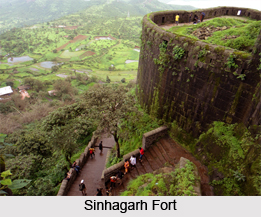 Sinhagad Fort is situated towards the southwest of Pune in the Indian state of Maharashtra. The fortress is also known as Kondhana Fort and Sinhgad or Sinhgarh. The geographical coordinates are latitude Coordinates 18A21`56.39?N and longitude 73A45`18.97?E. The structure played a significant role in several battles in the region, particularly in the Sinhagad battle in 1670. The fort was built in a strategic location and was surrounded by several other forts like Torna Fort, Purandar Fort and Rajgad Fort. It is located at a height of 1312 m above sea level on a cliff on the Bhuleswar range which is a part of the Sahyadris Mountain Range. The steep slopes of the hills provide natural defence to the structure. Thus walls, ramparts and bastions were erected only at the most important areas. Sinhagad Fort consisted of two entrance gates, namely the Pune Darwaza and the Kalyan Darwaza.
Sinhagad Fort is situated towards the southwest of Pune in the Indian state of Maharashtra. The fortress is also known as Kondhana Fort and Sinhgad or Sinhgarh. The geographical coordinates are latitude Coordinates 18A21`56.39?N and longitude 73A45`18.97?E. The structure played a significant role in several battles in the region, particularly in the Sinhagad battle in 1670. The fort was built in a strategic location and was surrounded by several other forts like Torna Fort, Purandar Fort and Rajgad Fort. It is located at a height of 1312 m above sea level on a cliff on the Bhuleswar range which is a part of the Sahyadris Mountain Range. The steep slopes of the hills provide natural defence to the structure. Thus walls, ramparts and bastions were erected only at the most important areas. Sinhagad Fort consisted of two entrance gates, namely the Pune Darwaza and the Kalyan Darwaza.
History of Sinhagad Fort
Sinhagad Fort was originally known as Kondana and was named after the sage Kaundinya. The carvings in the Kaundinyeshwar temple and the caves in the area indicate that the fortress was constructed around 2000 years ago. Muhammad bin Tughlaq seized the fort in 1328 AD from Nag Naik who was a Koli tribal chieftain. The Shahaji Bhosale, the commandant of Ibrahim Adil Shah I, controlled the Pune region during the rule of the Adil Shahi dynasty. However, Chhatrapati Shivaji Bhosale, the son of Shahaji, denied accepting the rule of the Adil shahi dynasty. In 1647, he occupied the Kondana fort by persuading the Adil Shahi Sardar Siddi Amber who controlled the structure at that time.
Later in 1649, the fortress was ceded to Adil Shah for the release of Shahaji Bhosale. But Shivaji again gained control of Sinhagad Fort with the support of Bapuji Mudgal Deshpande in 1656. The building was attacked by the forces of the Mughal dynasty in the years 1662, 1663 and 1665. Mirzaraje Jaysingh, the commander of the Mughal army took control of the fortress in 1665 under the Purandar Pact. Chhatrapati Shivaji Maharaj re-captured the fortress in 1670 and it was occupied by the Maratha Empire till 1689.
After Sambhaji Bhosale, the son of Shivaji, died, the Mughal Empire occupied Sinhagad Fort. However it was again seized by the Maratha army in 1693 under the leadership of Sardar Balkawade. During the Mughal invasion on Satara, Chatrapati Rajaram took refuge in the fortress and later died here on 3rd March 1700. Eventually Mughal Emperor Aurangzeb captured the structure in 1703. The Marathas regained control on the fortress once again in 1706 and occupied it until the year 1818. Later it was conquered by the British East India Company in 1818.
Architecture of Sinhagad Fort
The fort at Sinhagad comprises of a strong fortified wall which runs for almost 2 miles and includes 2 main gateways and 33 bastions. The gates, namely the Poona or Pune Darwaza and the Kalyan Darwaza, are located in the south east and the north east directions. The Pune Darwaza is located towards the north east; while the Kalyan Darwaza is situated towards the south east direction. The Poona Darwaza is considered to be more important than Kalyan Darwaza. It is protected by 3 gates which are also strongly defended. The Kalyan Darwaza comprises of 2 entrances. The north face of the hill is the strongest; hence it does not require any fortifications. The south face of the hill is perhaps the weakest.
The fort includes various buildings in the premises, such as horse stables, tanks and reservoirs, temples and other monuments. There are almost forty eight water tanks in and around the fortress. Devtanka is the most popular water reservoir. There is also a rock-cut tank to the left of the Poona Darwaza.
There is also a temple of Amrteswara Bhairav in the vicinity. The temple includes the idols of Bhairav and Bhairavi. Sinhagad Fort does not include a separate citadel, but there is a raised portion in the centre of the fort which was used for the purpose. The platform has a Kondaneswar temple. Apart from these, the fort also has the Tanaji Samadhi and the Rajaram Samadhi.
Present Condition of Sinhagad Fort
At present most of the fortress is in ruins. It is being utilized as a training centre for the National Defence Academy, Khadakwasla. Moreover the site has been developed as a popular tourist destination. Numerous people come to Sinhagad for picnic and trekking throughout the year.



















